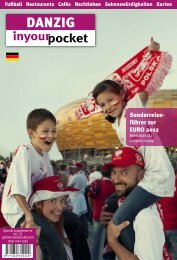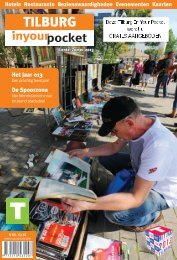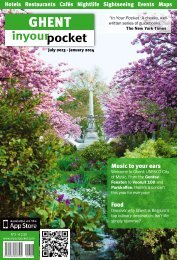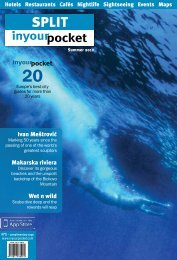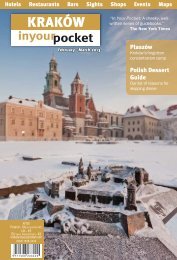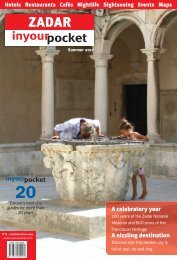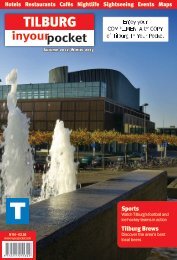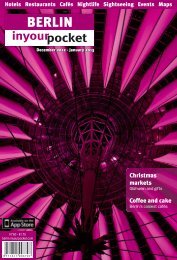7kh 7ul flw\ v prvw dxwkhqwlf 7h[ 0h[ uhvwdxudqw ... - In Your Pocket
7kh 7ul flw\ v prvw dxwkhqwlf 7h[ 0h[ uhvwdxudqw ... - In Your Pocket
7kh 7ul flw\ v prvw dxwkhqwlf 7h[ 0h[ uhvwdxudqw ... - In Your Pocket
You also want an ePaper? Increase the reach of your titles
YUMPU automatically turns print PDFs into web optimized ePapers that Google loves.
60 GDAŃSK WHAT TO SEE<br />
Essential Gdańsk<br />
If you’re pressed for time then do your best to squeeze<br />
in Gdańsk’s tourist highlights.<br />
It was in this city that the first fissures in the Iron Curtain<br />
appeared, forced open by Poles during the landmark<br />
August strikes of 1980. Following this first peaceful<br />
victory over the communist rulers, calls for greater<br />
freedoms were only nine years away from bringing down<br />
the Berlin Wall. The centre of these protests were Gate<br />
#2 of the Gdańsk shipyard and this can be found just<br />
outside of old town on ul. Doki (B-1). While there do not<br />
dare miss the Roads to Freedom exhibition (B-1, ul. Wały<br />
Piastowskie 24) close to the shipyards - a moving tribute<br />
to the Solidarity movement. And Gdańsk was not only the<br />
city where the fall of communism can be traced but is also<br />
the first shots of WWII were fired. WWII buffs should not<br />
miss the ferry ride (in season) up to the Westerplatte<br />
peninsula and to the Nowy Port lighthouse where the<br />
scars from the first shots of the war can still be seen.<br />
The old town is where you’ll find a number of photo opportunities<br />
and the sensible start point is The Upland Gate<br />
(B-4, Brama Wyżynna), which marks the start of what was<br />
once known as the Royal Road. Following this route you’ll<br />
pass by Amber Museum and the Torture Chamber (B-4,<br />
Katownia), through the Golden Gate (B-4, Złota Brama)<br />
and onto Long Street (ul. Długa). On the left about half way<br />
down is the Main Town Hall (C-4 Ratusz) which serves<br />
as the home of the Gdańsk History Museum and a few<br />
metres further on is the spot where Neptun’s fountain<br />
(C-5) and Artus Court (C-5, Dwór Artusa). The Royal Way<br />
ends at the impressive Green Gate (C-5, Zielona Brama)<br />
now the home of Lech Wałesa’s office.<br />
St. Mary’s Street (C-4, ulica Mariacka) ranks as the<br />
city’s most picturesque street and is dominated by<br />
the biggest brick church in the world St. Mary’s (C-4,<br />
Bazylika Mariacka). Climb to the top for panoramic<br />
views of the city. Nearby the 15th century Crane (D-4<br />
Żuraw) stands on the river’s edge, a hulking reminder<br />
of Gdańsk’s merchant past. Across the river the eery<br />
remains of Granary Island (D-4/5, Wyspa Spichrzów)<br />
serve as a somber reminder of the havoc wreaked here<br />
by WWII, while the Maritime Museum (including the<br />
ship Sołdek) provides an interesting look at the history<br />
of Polish seafaring.<br />
The old town’s compact nature means that it is easy<br />
enough to hit major landmarks such as St. John’s<br />
Church (C/D-3 Św. Jana), the Great Mill (B-3, Wielki<br />
Młyn) and Great Armoury (B-4, Wielka Zbrojownia)<br />
within a short walk.<br />
The Royal Way<br />
Upland Gate (Brama Wyżynna) B-4, ul. Wały<br />
Jagiellońskie. This 16th century gate, the main entrance<br />
into the Old Town, was the original starting point for the Royal<br />
Way. It was here that the Polish king was welcomed and given<br />
the keys to the city. The gate was originally surrounded by a<br />
50m moat and was named for its ‘upland’ location above the<br />
water level. The metal pulleys used for raising and lowering<br />
the drawbridges are still visible beneath the coats of arms<br />
of Poland, Prussia and Gdańsk.<br />
Prison Tower and Torture Chamber (Wieża<br />
Więzienna i Katownia) B-4, Targ Węglowy 26. Originally<br />
built as part of the city’s fortifications in the second half<br />
of the 14th century, the complex was rebuilt by Antoni van<br />
Obbergehn between 1593 and 1604 with the smaller of the<br />
two buildings becoming a torture chamber and courthouse<br />
while the larger tower became the prison. It was here that<br />
executions were carried out until the middle of the 19th<br />
century. Damaged during WWII, it has been extensively<br />
renovated and how houses the Amber and Torture Museums.<br />
Golden Gate (Złota Brama) B-4, ul. Długa. The<br />
virtues of Peace, Freedom, Wealth, Fame, Piety, Justice and<br />
Concord are depicted in allegorical statues adorning the<br />
balustrade of this gate overlooking ul. Długa. Built between<br />
1642-44, it was destroyed during WWII and not restored until<br />
1997. An inscription on the gate reads, ‘Small states grow<br />
by concord, great ones fall by disagreement.’<br />
Long Street (Ulica Długa) B/C-4. Picturesque ul.<br />
Długa is one of the city’s oldest thoroughfares. From the<br />
Golden Gate which protects it, the gently-curving street<br />
opens into an array of colourful burgher houses, roccoco<br />
portals, gothic mouldings and original porticoes. The house<br />
numbers run in opposite directions on either side, a feature<br />
typical of old Gdańsk streets. N° 12 houses a Museum of<br />
Burgher <strong>In</strong>teriors. N° 71 is one of the few structures on the<br />
street to survive World War II and still bears original mouldings<br />
from the second half of the 15th century. N° 28 is Dom<br />
Ferberów (Ferber’s House), dating to 1560, with magnificent<br />
sculptures and the three familiar coats of arms. N° 29 has<br />
an interesting crew of Roman emperors peering from its baroque<br />
façade. King Władysław IV entertained local dignitaries<br />
at Lwi Zamek (The Lion’s Castle) at N° 35; two lions guard<br />
its portal. The house neighbouring it dates to 1563 and is a<br />
splendid example of the influence of the Dutch renaissance<br />
on Gdańsk architecture. The renaissance house at N° 45<br />
belonged to the Schumann family and is sometimes called<br />
the House of the Polish Kings (Dom Królów Polskich); figures<br />
of Greek gods stud its alcoves. The eastern end of the street<br />
is dominated by the tall, slim tower of the Town Hall.<br />
Main Town Hall (Ratusz<br />
Głównego Miasta) C-4, ul.<br />
Długa 46/47, tel. (+48) 58 767<br />
91 00, www.mhmg.gda.pl. The<br />
Town Hall spire, with a golden replica<br />
of King Zygmunt August on its pinnacle,<br />
dominates ul. Długa’s skyline.<br />
Built in the late 14th century as the<br />
seat of city authorities, the Town<br />
Hall hosted many Polish kings. It was<br />
almost completely destroyed during<br />
WWII but rebuilt with extraordinary<br />
care. The tower contains a 37-bell<br />
clarion which was inaugurated on New Year’s Eve 2000. The<br />
interior of the building, home to Gdańsk History Museum today,<br />
is lushly decorated with painted ceilings, colourful frescoes and<br />
Gdańsk <strong>In</strong> <strong>Your</strong> <strong>Pocket</strong> gdansk.inyourpocket.com<br />
elaborate furniture and carvings. Two solemn lions guard its<br />
18th century portal, from where an elaborate staircase leads<br />
to the luxuriant Sala Czerwona, the Red Room. This room<br />
was used by the council in summer. Its ornamented ceiling<br />
is decorated with 25 paintings surrounding a central piece<br />
entitled The Glorification of the Unity of Gdańsk. Q Open<br />
10:00 - 16:00, Tue 10:00 - 15:00, Sun 11:00 - 16:00. Mon<br />
closed. Admission 10/5zł, family ticket 20zł. Tue free. From June<br />
open 10:00 - 19:00, Mon 10:00 - 15:00, Sun 11:00 - 19:00.<br />
Admission 10/5zł, family ticket 20zł. Mon free. From July open<br />
10:00 - 18:00, Mon 10:00 - 15:00, Sun 11:00 - 18:00. Admission<br />
10/5zł, family ticket 20zł. Mon free.<br />
Long Market & Neptune Fountain (Długi Targ i<br />
Fontanna Neptuna) C-5. The focal point of Długi Targ,<br />
the Long Market, is the Neptune Fountain, a bronze statue<br />
of the sea god erected in 1549 and converted to a fountain<br />
in 1633 and restored in 2011/12. During WWII, this symbol<br />
of Gdańsk was dismantled and hidden with many of the city’s<br />
other treasures. It was only returned to its rightful place in<br />
1954. The square itself is surrounded by colourful and ornate<br />
houses which look magnificent when the sun is beating off<br />
their decorated walls. Długi Targ used to be home to Gdańsk’s<br />
richest, most elite residents and was used for assemblies.<br />
Executions took place on the square in front of Artus Court.<br />
Artus Court (Dwór Artusa) C-5, Długi Targ 43/44, tel.<br />
(+48) 58 767 91 83, www.mhmg.gda.pl. This impressive<br />
mansion, a symbol of the city’s power in the 16th and 17th<br />
centuries, served as an exchange and as the seat of St.<br />
George and the brotherhoods of rich patricians. Founded as<br />
a meeting place for merchants and dignitaries, it was named<br />
after King Arthur, of round table fame, and hosted many a<br />
noble guest. Following a fire in 1841, it was given a more Gothic<br />
form, complete with ostentatious sculptures and paintings<br />
illustrating man’s merits and vices. <strong>In</strong>side, the centrepiece of<br />
the main hall is a 10.64-metre renaissance tiled stove dating<br />
to 1546, made of more than 500 individual tiles and the tallest<br />
of its kind in Europe. Its adornments portray leaders, coats of<br />
arms and allegorical figures. Just to the left is a small pewter<br />
surface that claims to be the oldest table in Poland while two<br />
stone lions protect the entrance to the cellars of the court.<br />
The court still plays an important part in public life today and<br />
is the scene of important receptions and meetings. Q Open<br />
10:00 - 16:00, Tue 10:00 - 15:00, Sun 11:00 - 16:00. Mon<br />
closed. Admission 10/5zł, family ticket 20zł. Tue free. From<br />
June open 10:00 - 19:00, Mon 10:00 - 15:00, Sun 11:00 -<br />
19:00. Admission 10/5zł, family ticket 20zł. Mon free. From July<br />
open 10:00 - 18:00, Mon 10:00 - 15:00, Sun 11:00 - 18:00.<br />
Admission 10/5zł, family ticket 20zł. Mon free.<br />
Green Gate (Zielona<br />
Brama) C-5, Długi Targ<br />
24, tel. (+48) 58 307<br />
59 12 ext. 102, www.<br />
muzeum.narodowe.gda.<br />
pl. This magnificent fourarched<br />
gatehouse on the<br />
waterfront was built as a<br />
palace for Polish monarchs.<br />
No Polish king ever stayed<br />
in the building, but Lech<br />
Wałęsa has his office here:<br />
you’ll see his nameplates<br />
on the walls of the gate. The gate leads to the Green Bridge,<br />
which spans the Motława River and which used to be raised<br />
to stop the riff-raff from getting into the Old Town. Following<br />
a careful renovation the gate now bears an uncanny resemblance<br />
to Amsterdam’s central train station, and is frequently<br />
home to passing exhibitions.<br />
gdansk.inyourpocket.com<br />
GDAŃSK WHAT TO SEE<br />
Agnieszka Syroka<br />
Tour Guide & Tour Leader<br />
Gdańsk - Sopot - Gdynia - Malbork Castle<br />
Frombork - Pomerania<br />
Mobile: +48 502-554-584<br />
email: asyroka@interia.pl<br />
www.tourguidegdansk.com<br />
May - July 2012<br />
61



